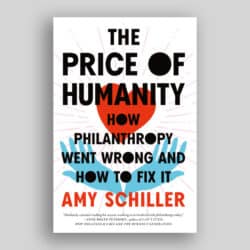Walker, Darren, From Generosity to Justice: A New Gospel of Wealth. The Ford Foundation/Disruption Books, 2019 (no ISBN); available online at: https://www.fordfoundation.org/new-gospel-media/GenerositytoJustice.pdf
Reich, Rob. Just Giving – Why Philanthropy Is Failing Democracy and How It Can Do Better. Princeton University Press, 2018 ISBN 978-0-691-18349-7
Darren Walker’s From Generosity to Justice: A New Gospel of Wealth aspires to both update Andrew Carnegie’s 1889 “The Gospel of Wealth” and contribute to the debate over the merits of philanthropy that was sparked by – or at least coincides with – recent rising concerns about inequality. In that context, several critics have come forward to highlight the charitable sector’s shortcomings in what’s been called the “the new gilded age.”
Prominent among them is Anand Giridharadas, whose Winners Take All focuses on the devolving of responsibility for social problems from the state to wealthy individuals. Individuals who, he argues, can unaccountably decide what issues they want to address and how. It is a model that Giridhardas says is a stalking horse for lower tax rates on upper income earners, and which obfuscates some of the oppressive practices that allowed these people to generate their wealth. Another critic is Edgar Villanueva, whose Decolonizing Wealth: Indigenous Wisdom to Heal Divides and Restore Balance calls for moving away from the vestiges of colonialism, still present in some philanthropic work, to an approach that is more equitable, interdependent, and reciprocal. His approach calls for a fundamental shift in philanthropy toward community-driven change, putting emphasis on proximity and understanding of community needs.
A third, and perhaps more direct challenge, to entities like the Ford Foundation comes from academic Rob Reich. Reich’s particular concern, in his Just Giving – Why Philanthropy Is Failing Democracy and How It Can Do Better, is that private foundations in the US in their current legal form are not compatible with democratic values. His book ranges over theory and experience in several academic disciplines, and his specific criticisms of private foundations are that they are unaccountable, not transparent, plutocratic, and driven more by tax considerations than by a desire to deliver public benefit.
Walker does not have answers to all the complaints raised by Reich and others, but through examples interviews, and analysis he points out how innovative and impactful projects can happen within current structures. Like Reich, Walker is interested in moving beyond mere giving, to giving that is fairer and more equitable, and that reforms systems and embeds long-term change.
Reich’s closely argued analysis grapples with whether giving in the US, and in other countries where the state has similarly adopted measures to encourage philanthropy, is “just” – i.e., in aim and effect reduces economic inequality. He suggests that, by-and-large, it does not. Walker’s lens is wider. He acknowledges the limits of charity focusing on relieving immediate needs and wants to push for philanthropy that promotes transformative outcomes – to move, as he put it, from “generosity to justice.” But he also discusses initiatives that potentially change quality of life beyond the realm of economics.
Reich offers some modest suggestions for structural reform and develops a rationale for why private foundations should stay in the mix of charitable options. Walker suggests that attitude shifts can address many of the faults with contemporary philanthropy; he is less concerned with tax or regulatory changes to revamp the system.
Reich begins with a discussion of some historical examples of institutional forms of philanthropy and, in doing so, Just Giving places private foundations as we know them today in a broader context. Delving into three different periods and cultures, this material looks at both past practice and debate over what structures are appropriate to allow voluntary contributions to public purposes by the well-to-do. It closes with some skepticism about the forerunners of modern foundations in the 18th and 19th centuries, showing that discomfort with these institutions has deep roots.
Meanwhile, Walker starts with Carnegie’s “The Gospel and Wealth.” He wants to move beyond Carnegie’s vision of wealthy individuals having an obligation to help the less fortunate and promote a bolder philanthropy that works toward changing or improving societal structures as well as the personal circumstances of individuals. He sees this as building on the Carnegie approach, rather than something that requires the old approach to be completely discarded. In this analysis, philanthropy is viewed as a continuum.
For Reich the issue of equality and philanthropy is very much tied to the preferential tax treatment available to modern charities, including foundations, and their donors. His analysis argues that the current US tax structure means that charitable giving contributes to, rather than reduces, inequality. This stems both its itemization threshold for tax filers, and from US contributions being treated as deductions rather than being dealt with as credits. Essentially, Reich argues, these approaches lead to more generous treatment of contributions from wealthier donors, which statistics and anecdotal evidence both indicate are less apt to be channeled to charities whose work reduces inequality.
Walker does not delve deeply into this. Instead, he discusses such issues as the risk of philanthropists imposing their solutions on stakeholders, giving rise to new problems in place of the old. He calls for closer attention to be paid to the “voices of those most affected by injustice” and says that successful outcomes require doing so. He also explores the need to come to terms with “privilege” and power discrepancies in philanthropic initiatives, arguing for a kind of charity jujitsu model where privilege is put to work for the cause, rather than being a hindrance.
In the current political climate, the choice of equality as the best lens through which to view philanthropy is unsurprising, but perhaps leads, at least in Reich’s analysis, to an over-emphasis on dollars and cents. Many parts of the charitable sector, not least religious and cultural organizations, are valued because they enhance quality of life not because they improve someone’s economic wellbeing.
Through his interviews and examples in the arts, education, and human rights, Walker avoids over-emphasising the financial. In doing so, he provides some insightful ideas for thinking about impact beyond economic wellbeing. One of these is in a conversation with activist Ai-jen Poo, who links justice to agency, and touts philanthropy’s role in providing agency for people to define and make choices in life and democracy.
One key element of Reich’s analysis, which is expressed in his proposed political theory of philanthropy, is an appropriate balancing of liberty and justice. In Reich’s view, achieving this balance requires justification of both any restrictions on the right of the philanthropic donor to give away his or her property and of any incentive provided by the state to encourage donations.
This leads Reich to a canvassing of rationale for philanthropic tax incentives. He finds merit in the efficiency and pluralism justifications for tax support of charities. The efficiency rationale (a model that sees charities being better positioned to produce certain things of social value than government) is, however, made less compelling for Reich as a justification by the difficulty of showing that sector groups outperform government. Leaving aside the issue of measuring performance in purely economic terms, one would think that in this context the sweat equity and leveraging of volunteer time that are characteristic of voluntary organizations ought to be plumbed. However, Just Giving doesn’t look at those factors.
In Reich’s analysis of the pluralism justification (a model featuring multiple, diverse, and de-centralized charities operating to benefit individuals or society in a wide variety of ways), he notes it would be better supported by a tax credit system. He argues that the current US deduction system tends to promote plutocracy, explaining that a tax credit system would eliminate the advantage enjoyed by wealthier donors under the current US tax regime and result in all donors being treated the same. Unfortunately, Reich avoids any mention of Canada’s charitable tax credit system, so misses an opportunity to explore empirical evidence for the change he proposes.
Walker’s From Generosity to Justice goes at this problem in a somewhat different way. It features a chapter on “New Paradigms For Legacy Institutions,” which addresses the evolving role of philanthropy. The chapter touches on wealth redistribution, fighting injustice, and changing generational views on how philanthropy ought to work. While Walker’s writing generally suggests a positive outlook for change, much of the impetus for taking more progressive approaches appears to hinge on goodwill and adopting the right attitudes. These factors may be present in some circumstances but fall short of the regulatory change that some critics see as essential to stemming failures and abuses of current structures.
In the fourth chapter of Just Giving, Reich provides some historical background of the origins of the Rockefeller Foundation. When that organization was being established, there was a desire to constitute it as a national rather than state group. At the time, this would have required an Act of Congress. Because it was politically controversial, several measures were proposed to address concerns with the initiative. These included, among other things, proposed institutional features that would have dealt with limiting its size and longevity, and buttressing its public accountability. When the attempt at being federally constituted failed, and the group was instead established at the state level, the chance to test these innovative structural proposals was lost.
The balance of the chapter deals with the elements of foundations that are commonly critiqued. These include lack of accountability and transparency, donor direction of the organization’s purpose in perpetuity, and the generous tax subsidization received by these groups. Reich then turns to two arguments in favour of private foundations. The first focuses on promoting pluralism, while the second discusses the potential role of foundations in fostering innovation and testing solutions in social policy.
Walker doesn’t offer much by way of justifying the existence of private foundations as a legal structure. He is content merely to describe a world in which they are significant players.
Some of Walker’s material, however, at least by way of example, offers a different rationale for private foundations that perhaps bears exploration. One is the insulation to address controversial matters available to endowed private foundations, which operating charities may not enjoy because they are apt to be more sensitive to – or to put things more bluntly, need to be more responsive to – government funders or donors. Even where there is no direct threat of withholding resources, operating charities may be reluctant to speak out on controversial topics because they fear longer term alienation of government or public stakeholders. This is, perhaps, the flip side of the knock on private foundations for being “unaccountable.”
Reich repeatedly expresses concern with the potential of certain foundations to exist in perpetuity. His answer to this is to suggest time-limiting their existence. But like taking unpopular or controversial stances, foundations may also be positioned to support worthwhile, but undervalued, initiatives either within individual organizations or for groups of charities. Reich makes much of the freedom of foundations to innovate, but he doesn’t deal much with their scope to be a stable funder for work that otherwise would not get done. His observations in this regard are supplemented by Walker’s material.
Many operating charities are preoccupied with frontline activities, and so give policy, governance, or administrative initiatives short shrift. This is usually work that donors are unlikely to support, and it often takes a lot of time for even a private foundation to come to appreciate the importance of such efforts. Even then, it is a small minority of foundations that are willing to engage in this space. As one person in Walker’s book comments:
“Policy work is underinvested in because donors who contribute money for a capital campaign on a new building can point directly at the proverbial brick in the building and say, ‘I paid for this. And I can see directly the results of my contribution.’ With policy, it’s difficult to know what the counterfactual would have been, or to try to understand success in the short and medium terms.”
In this context, it seems counterproductive to mandate winding up groups that may be just at a stage in their lifecycle where they are willing to take on this type of work and provide the stable, ongoing funding which may well spell the difference between big picture success and failure.
To remedy the failings of private foundations, as well as reform the tax treatment they receive, Reich proposes long-term – which he describes as “intergenerational” – reporting. He also calls for implementation of a peer review style system to assess the strategies and results of private foundation work as safeguards to keep these groups on track. These are interesting innovations, although how they could be practically implemented isn’t fully clear.
Reich’s book features a fascinating discussion of one of the key questions for foundations: balancing the needs of future generations with those of the current generation. Since the inception of endowments, husbanding resources for the coming years or decades versus spending them now has been a frequent subject of debate both at the level of individual organizations and at the sectoral level. Just Giving analyzes this issue based on weighing the delivery of public benefit to future generations against providing resources to those least advantaged in contemporary society. It argues that philanthropy and, more specifically because of their nature, private foundations can buttress development and maintenance of social capital and offset “short-termism” and “presentism” in some parts of the current democratic process.
A similar conundrum arises from the analysis in Walker’s book. Acknowledging that philanthropy is a continuum ranging from frontline service delivery to initiatives designed to tackle root problems, it is not clear – beyond the preference of the board or staff of a particular foundation – how it ought to be decided where along the continuum particular organizations should operate. The tenets of a “New Gospel of Wealth” that Walker suggests seem to lean rather heavily in favour of going after root causes, and that may be appropriate in the context of the Ford Foundation. But for other groups, a framework for sorting out how to balance the competing imperatives of fixing the frontline and fixing the system, along the lines of that offered by Reich to deal with the issue of present versus future spending, would be welcome.
That is but one of the many compelling questions arising from these two thoughtful books.


